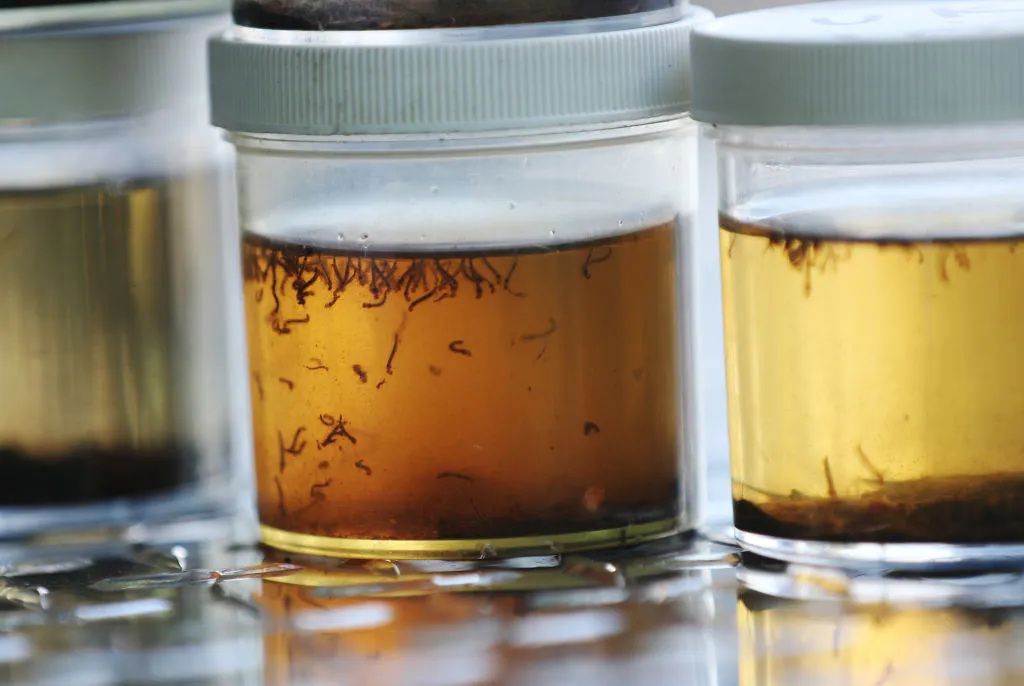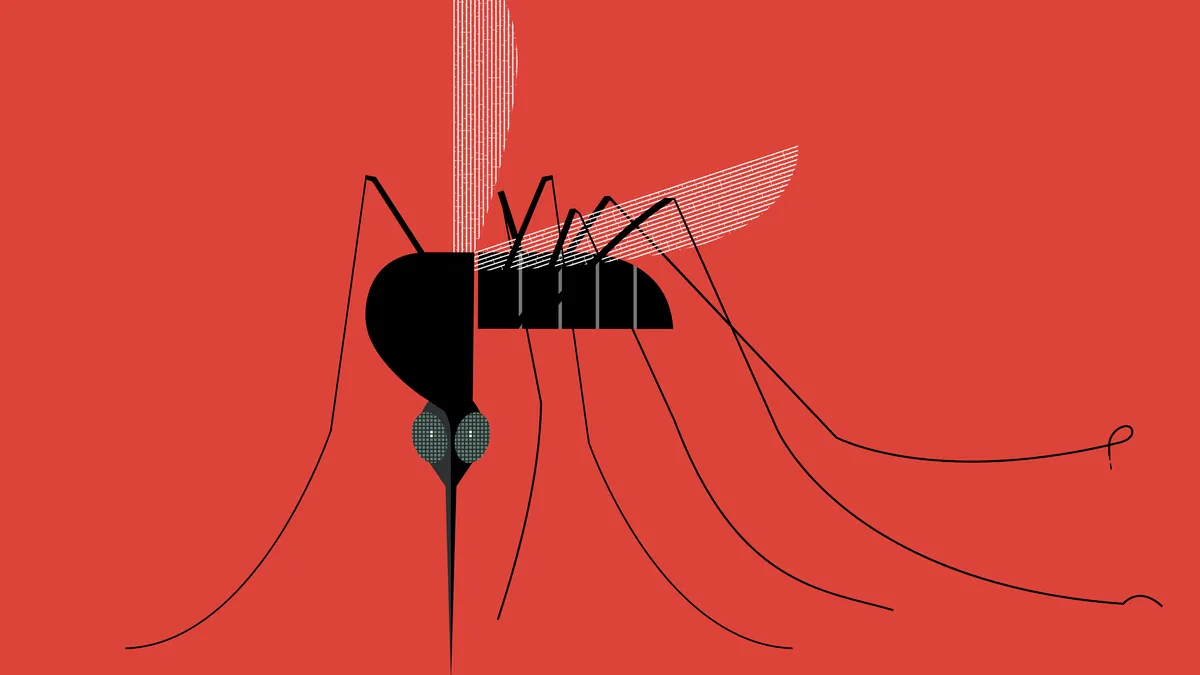Mosquitoes are less than an inch long and typically weigh 2.5 milligrams, but they exact a heavy toll and have been called the “deadliest animal on Earth.”
Female mosquitoes feed off human and animal hosts, siphoning a fraction of a milliliter of blood at a time to gain the protein they need to produce eggs. These fleeting interactions expose millions of people annually to dangerous illnesses like malaria, dengue, West Nile virus, Zika, chikungunya and Yellow Fever. Malaria alone sickened 247 million people in 2021 and killed more than 600,000, most of them children.
“It’s a big problem and there’s a lot of people that suffer because of [mosquito-borne illnesses] around the world,” said Dr. Matthew Memoli, director of the Laboratory of Infectious Diseases Clinical Studies Unit at the National Institute of Allergy and Infectious Diseases at the National Institutes for Health.
While these diseases are less common in the U.S. than in other parts of the world, some experts believe they are becoming more prevalent as mosquitoes move into new areas due to deforestation, changes in land use and temperature shifts linked to climate change. In 2023, there were three locally-acquired malaria cases in Florida, Texas and Maryland, and over the years there have been dengue outbreaks in Florida, Hawaii and Texas. Memoli said the recent rise in cases might not be related to increased risk but better surveillance technology.
“The question becomes: Are we really seeing it more or are we just able to find it now when we couldn't find it before?” he said.
For decades, scientists have strived to create a slam-dunk vaccine for many mosquito-borne diseases, particularly malaria and dengue — the most common and deadly types. However, success has been hampered by the complexity of the viruses and parasites involved, as well as drug development and market-related challenges.
Now, as humans continue their struggle with these dangerous insects, new vaccines are finally gaining ground.
Where the pipeline stands
Although the search for a malaria vaccine began in the 1960s, the first option — GSK’s Mosquirix —didn’t gain approval until 2021. But the shot is only 35% effective in preventing infection and last year, Reuters reported that funding challenges were keeping GSK from producing enough needed doses. A second vaccine, R21/Matrix-M, developed at the University of Oxford and the Serum Institute of India with a Novavax adjuvant, is about 66% effective and gained a recommendation from the World Health Organization in October.
There are also two dengue vaccines in use —Sanofi’s Dengvaxia, and Qdenga from Takeda — and one for Yellow fever, Sanofi’s YF-VAX. On Nov. 9, the FDA signed off on an accelerated approval for the first chikungunya vaccine, Ixchiq, from the French biotech Valneva.
But for Zika and West Nile Virus, which is the most prevalent mosquito-borne illness in the U.S., a viable shot has remained elusive. Progress on Zika vaccines slowed when viral outbreaks waned, making it difficult to run clinical trials. Researchers are trying to overcome this problem by deliberately exposing people to the virus in human challenge studies. West Nile Vaccines have made it into phase 1 and 2 trials but haven’t gone further due to concerns about cost, vaccine safety and the difficulty of designing trials that can show the vaccines are effective against a disease that occurs unpredictably.

Public health officials around the world also use vaccines in combination with other mosquito-control strategies, such as preventing bites and controlling mosquito population through genetically modified mosquitoes in problem areas to cut the number of female mosquitoes that survive into adulthood.
Numerous new shots for mosquito-borne illnesses are in the works including an mRNA malaria vaccine, BNT165, which uses a novel multi-antigen approach and is now in phase 1 from BioNTech. The company hopes it will provide a highly effective option that’s easy to manufacture.
Valneva has an earlier-stage vaccine, VLA1601, for Zika, built on the same platform as the company’s approved Japanese encephalitis vaccine, Ixiaro. Moderna is in phase 2 on its Zika candidate mRNA-1893, which was well tolerated and induced a strong immune response to the virus in phase 1.
One shot to rule them all?
While all of these vaccines target individual diseases, London-based Seek is taking a wholly different approach to the mosquito problem with a universal vaccine that could target multiple diseases simultaneously. The investigational vaccine, AGS-v-Plus, is now poised to move into phase 2 and targets the mosquito bite, not an organism, said Memoli, who helped lead the effort to develop the vaccine.
“[Research] approaches have always [aimed] to make vaccines against the single organism. You're trying to make a malaria vaccine, you're trying to make a Zika vaccine, trying to make a dengue vaccine, but you're ignoring the insect vector,” he said.
“The [universal vaccine] approach itself needs to have continued research and there could be lots of different versions of it.”

Dr. Matthew Memoli
Director, Laboratory of Infectious Diseases Clinical Studies Unit, National Institute of Allergy and Infectious Diseases, NIH
AGS-v-Plus targets a protein in the mosquito’s saliva that expands blood vessels, allowing the mosquito easier access to its blood meal. This protein then triggers an allergic reaction that brings forth the familiar angry, itchy red welt. It also suppresses the immune system’s ability to mount an attack against the invading organism because infectious and allergic immune responses can’t occur simultaneously, Memoli said.
“The allergic response makes you susceptible to the infection. It allows the malaria parasite or the Zika virus, the dengue virus, to actually infect you,” Memoli said.
To prevent this, the vaccine introduces mosquito salivary proteins or peptides that block the allergic response, allowing the body’s infectious disease mechanism to step forward and attack the invading organism.
“The beauty of the saliva approach is that it’s nonspecific. It would work against any virus or parasite carried by the mosquito, whereas the specific vaccine is only good against that one organism,” Memoli said.
Because AGS-v-Plus engages the immune system, it might work better alongside infection-specific vaccines that could boost its defensive power.
“Then you'd have a two-pronged attack instead of a one-pronged attack,” Memoli said.
NIH took AGS-v-Plus through phase 1 testing and found it was safe and induced a robust immune response. Seek is now designing a phase 2 trial in an area where malaria is endemic, Memoli said.
Benefits beyond mosquitoes
The broadly protective approach of the Seek vaccine might also be effective against other insect-borne illnesses.
“I am now working on some other similar approaches,” Memoli said, including a vaccine targeting the sand fly bite, which can cause leishmaniasis. Another research team at NIH is also developing a similar vaccine for tick bites, which cause several diseases ranging from Lyme disease to Rocky Mountain spotted fever.
“The [universal vaccine] approach itself needs to have continued research and there could be lots of different versions of it and different ways that could be used,” Memoli said. “My goal was to show this is safe in human beings, and it does have an effect. Let's try to figure out how we can use it.”
One of the challenges experts will need to wrangle with if AGS-v-Plus gains approval is how to use the vaccine most effectively, he said. For example, should it be used in endemic areas where disease exposure occurs very early in infants and people experience repeated infections? Or would it be more appropriate for travelers? Upcoming AGS-v-Plus trials will gauge how much protection the vaccine affords.
“I think if we figure out the right combination, the right way to use it, I think it could be very, very protective,” Memoli said.
If these efforts to add to the vaccine arsenal are successful, it could one day help turn the mosquito from a major threat into a buzzing annoyance.



















